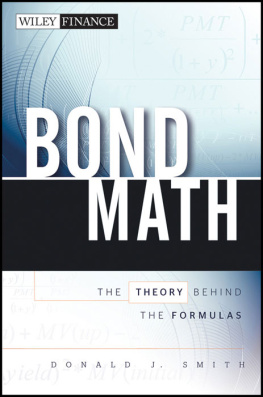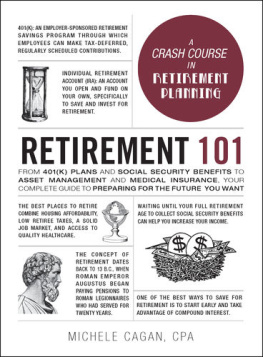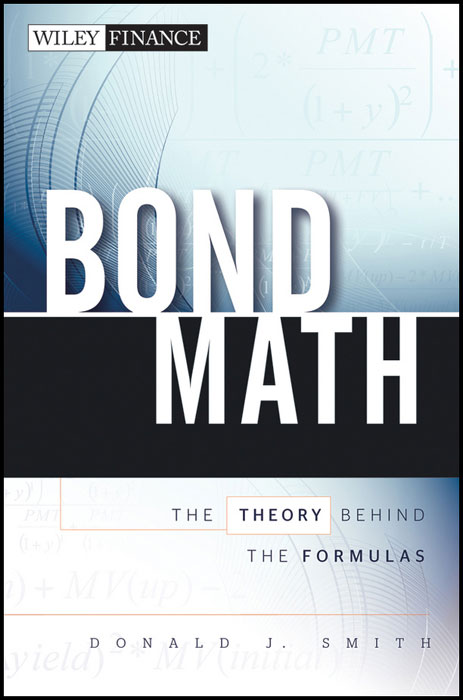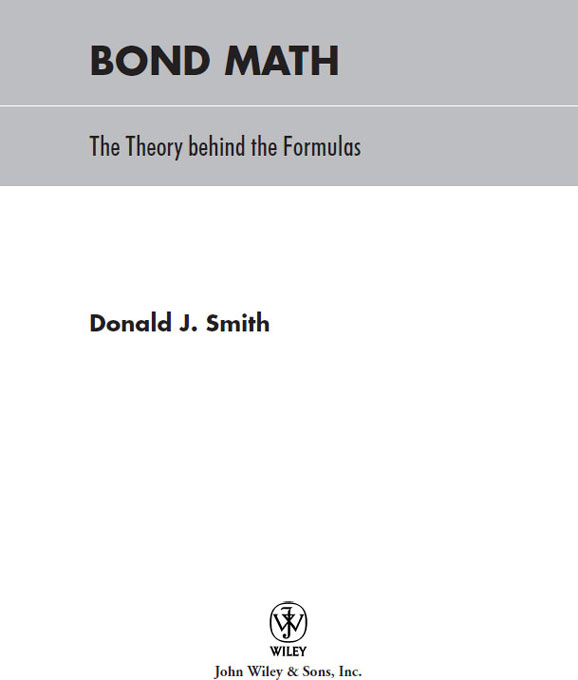Copyright 2011 by Donald J. Smith. All rights reserved.
Published by John Wiley & Sons, Inc., Hoboken, New Jersey.
Published simultaneously in Canada.
No part of this publication may be reproduced, stored in a retrieval system, or transmitted in any form or by any means, electronic, mechanical, photocopying, recording, scanning, or otherwise, except as permitted under Section 107 or 108 of the 1976 United States Copyright Act, without either the prior written permission of the Publisher, or authorization through payment of the appropriate per-copy fee to the Copyright Clearance Center, Inc., 222 Rosewood Drive, Danvers, MA 01923, (978) 750-8400, fax (978) 646-8600, or on the Web at www.copyright.com. Requests to the Publisher for permission should be addressed to the Permissions Department, John Wiley & Sons, Inc., 111 River Street, Hoboken, NJ 07030, (201) 748-6011, fax (201) 748-6008, or online at http://www.wiley.com/go/permissions .
Limit of Liability/Disclaimer of Warranty: While the publisher and author have used their best efforts in preparing this book, they make no representations or warranties with respect to the accuracy or completeness of the contents of this book and specifically disclaim any implied warranties of merchantability or fitness for a particular purpose. No warranty may be created or extended by sales representatives or written sales materials. The advice and strategies contained herein may not be suitable for your situation. You should consult with a professional where appropriate. Neither the publisher nor author shall be liable for any loss of profit or any other commercial damages, including but not limited to special, incidental, consequential, or other damages.
For general information on our other products and services or for technical support, please contact our Customer Care Department within the United States at (800) 762-2974, outside the United States at (317) 572-3993 or fax (317) 572-4002.
Wiley also publishes its books in a variety of electronic formats. Some content that appears in print may not be available in electronic books. For more information about Wiley products, visit our web site at www.wiley.com .
Library of Congress Cataloging-in-Publication Data:
Smith, Donald J., 1947
Bond math : the theory behind the formulas / Donald J. Smith.
p. cm.
Includes bibliographical references and index.
ISBN 978-1-57660-306-2 (cloth); ISBN 978-1-1181-0317-3 (ebk);
ISBN 978-0-4708-7921-4 (ebk); ISBN 978-1-1181-0316-6 (ebk)
1. BondsMathematical models. 2. Interest ratesMathematical models. 3. Zero coupon securities. I. Title.
HG4651.S57 2011
332.632301519dc22
2011002031
To my students
Preface
This book could be titled Applied Bond Math or, perhaps, Practical Bond Math . Those who do serious research on fixed-income securities and markets know that this subject matter goes far beyond the mathematics covered herein. Those who are interested in discussions about pricing kernels and stochastic discount rates will have to look elsewhere. My target audience is those who work in the finance industry (or aspire to), know what a Bloomberg page is, and in the course of the day might hear or use terms such as yield to maturity, forward curve, and modified duration.
My objective in Bond Math is to explain the theory and assumptions that lie behind the commonly used statistics regarding the risk and return on bonds. I show many of the formulas that are used to calculate yield and duration statistics and, in the Technical Appendix, their formal derivations. But I do not expect a reader to actually use the formulas or do the calculations. There is much to be gained by recognizing that there exists an equation and becoming more comfortable using a number that is taken from a Bloomberg page, knowing that the result could have been obtained using a bond math formula.
This book is based on my 25 years of experience teaching this material to graduate students and finance professionals. For that, I thank the many deans, department chairs, and program directors at the Boston University School of Management who have allowed me to continue teaching fixed-income courses over the years. I thank Euromoney Training in New York and Hong Kong for organizing four-day intensive courses for me all over the world. I thank training coordinators at Chase Manhattan Bank (and its heritage banks, Manufacturers Hanover and Chemical), Lehman Brothers, and the Bank of Boston for paying me handsomely to teach their employees on so many occasions in so many interesting venues. Bond math has been very, very good to me.
The title of this book emanates from an eponymous two-day course I taught many years ago at the old Manny Hanny. (Okay, I admit that I have always wanted to use the word eponymous; now I can cross that off of my bucket list.) I thank Keith Brown of the University of Texas at Austin, who co-designed and co-taught many of those executive training courses, for emphasizing the value of relating the formulas to results reported on Bloomberg. I have found that users of black box technologies find comfort in knowing how those bond numbers are calculated, which ones are useful, which ones are essentially meaningless, and which ones are just wrong.
Our journey through applied and practical bond math starts in the money market, where we have to deal with anachronisms like discount rates and a 360-day year. A key point in Chapter 1 is that knowing the periodicity of an annual interest rate (i.e., the assumed number of periods in the year) is critical. Converting from one periodicity to anotherfor instance, from quarterly to semiannualis a core bond math calculation that I use throughout the book. Money market rates can be deceiving because they are not intuitive and do not follow classic time-value-of-money principles taught in introductory finance courses. You have to know what you are doing to play with T-bills, commercial paper, and bankers acceptances.
Chapters 2 and 3 go deep into calculating prices and yields, first on zero-coupon bonds to get the ideas out for a simple security like U.S. Treasury STRIPS (i.e., just two cash flows) and then on coupon bonds for which coupon reinvestment is an issue. The yield to maturity on a bond is a summary statistic about its cash flowsit's important to know the assumptions that underlie this widely quoted measure of an investor's rate of return and what to do when those assumptions are untenable. I decipher Bloomberg's Yield Analysis page for a typical corporate bond, showing the math behind street convention, U.S. government equivalent, and true yields. The problem is distinguishing between yields that are pure data (and can be overlooked) and those that provide information useful in making a decision about the bond.
Chapter 4 continues the exploration of rate-of-return measures on an after-tax basis for corporate, Treasury, and municipal bonds. Like all tax matters, this necessarily gets technical and complicated. Taxation, at least in the U.S., depends on when the bond was issued (there were significant changes in the 1980s and 1990s), at what issuance price (there are different rules for original issue discount bonds), and whether a bond issued at (or close to) par value is later purchased at a premium or discount. Given the inevitability of taxes, this is important stuffand it is stuff on which Bloomberg sometimes reports a misleading result, at least for U.S. investors.
Yield curve analysis, in Chapter 5, is arguably the most important topic in the book. There are many practical applications arising from bootstrapped implied zero-coupon (or spot) rates and implied forward ratesidentifying arbitrage opportunities, obtaining discount factors to get present values, calculating spreads, and pricing and valuing derivatives. However, the operative assumption in this analysis is no arbitragethat is, transactions costs and counterparty credit risk are sufficiently small so that trading eliminates any arbitrage opportunity. Therefore, while mathematically elegant, yield curve analysis is best applied to Treasury securities and LIBOR-based interest rate derivatives for which the no-arbitrage assumption is reasonable.














